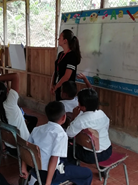With the title "In Matina, we inform and transform," the aim is to disseminate information generated by researchers from the Regional Institute of Toxic Substances Studies (IRET) at the National University (UNA). The team of professionals from the Infants and Environmental Health Program (ISA) developed a strategy to deliver research results from the past 10 years to various populations affected by pesticide exposure in banana plantations. This effort involved visiting 37 schools in the canton during the first semester of 2019.

The objectives of this workshop series were focused on informing children, aged 6 to 12 years old, and their families about the consequences of pollution caused by the application of toxic substances within banana plantations.
The methodology employed for the workshops allowed for periods of engaging and pedagogically rich interactions. To achieve this, the use of audiovisual resources was recurrent to contextualize the audience about the environmental issues identified in this region of the Costa Rican Caribbean. The sessions with the children consisted of two small phases, conducted over two lessons for each group of the first cycle. The first phase addressed environmental pollution and its impacts on ecosystem well-being and human health through video presentations, while the second phase involved practical activities where water quality was determined through the identification of macroinvertebrates as indicators of such quality.

In the case of workshops with family members, a longer audiovisual resource was prepared, which correlated the environmental situation with the effects on the children who are part of the cohort, highlighting the impacts on socio-emotional development, visuo-motor skills, and executive functions (working memory, inhibitory control, attention, planning, etc.). It is worth noting that with the legal guardians who attended these meetings, possible measures to reduce environmental exposure that can be managed from home were discussed.
As an example, one of the topics covered was the care that should be taken when washing work clothes used in the banana plantation, apart from the clothes of other family members; as well as the prudent times that a pregnant mother should wait indoors to avoid contact with airborne contaminants from aerial fumigation. With this latter group, Regulation No. 31520 for Agricultural Aviation activities was also examined, mentioning relevant aspects regarding compliance with distances in aerial pesticide applications concerning population centers or farms; where, in the case of a buffer zone, the distance can be reduced from 100 to 30 meters.
Through the extension work, it is estimated that the population served totals 3,174 individuals, including children and their families, as well as teaching and administrative staff from the 37 educational centers located geographically within the study area, which encompasses three regional offices and four circuits of the Ministry of Public Education (MEP). Undoubtedly, this work is made possible by the transdisciplinary efforts of professionals from different areas of expertise, members of the Faculty of Earth and Sea Sciences (FCTM), and the Research and Teaching Center in Education (CIDE).



